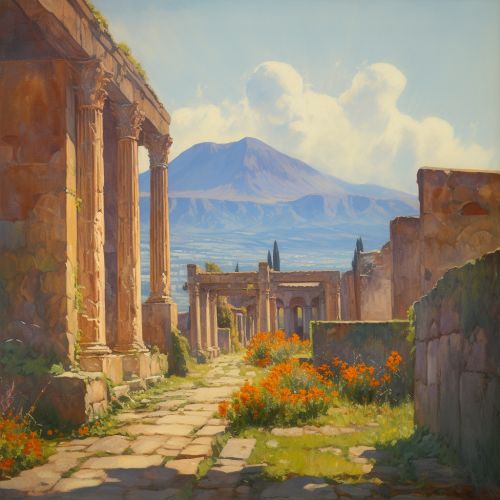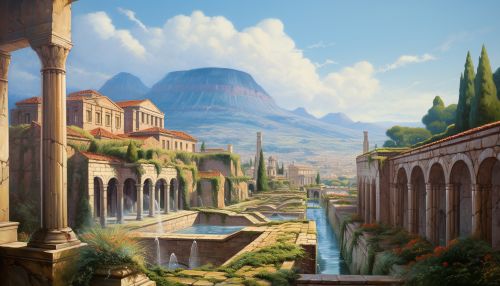Pompeii
History
Pompeii was an ancient city located in the modern comune of Pompei near Naples in the Campania region of Italy. Pompeii, along with Herculaneum and many villas in the surrounding area (e.g. at Boscoreale, Stabiae), was buried under 4 to 6 m (13 to 20 ft) of volcanic ash and pumice in the eruption of Mount Vesuvius in AD 79.
Largely preserved under the ash, the excavated city offers a unique snapshot of Roman life, frozen at the moment it was buried and providing an extraordinarily detailed insight into the everyday life of its inhabitants. It was a wealthy town, enjoying many fine public buildings and luxurious private houses with lavish decorations, furnishings and works of art which were the main attractions for the early excavators. Organic remains, including wooden objects and human bodies, were entombed in the ash and decayed leaving voids which archaeologists found could be used as moulds to make plaster casts of unique and often gruesome figures in their final moments of life.
Pompeii is a UNESCO World Heritage Site and is one of the most popular tourist attractions in Italy, with approximately 2.5 million visitors annually.


Geography and Demographics
Before the eruption, Pompeii was a thriving city with a population of around 11,000 people. It was located near the coast of the Bay of Naples, and was only about five miles away from Mount Vesuvius. The city covered a total area of about 64 to 67 hectares (170 acres) and was home to a complex water system, gymnasium, and a port.
The people of Pompeii were a mix of cultures, as it was a busy port and trading town. The population included wealthy families who lived in grand houses with elaborate decorations, middle-class families who lived in comfortable homes, and a large number of slaves who lived in cramped quarters. There were also many freedmen and women – former slaves who had bought their freedom or been freed by their masters.
Architecture and Infrastructure
Pompeii was a well-developed and prosperous city. The architecture of Pompeii is seen as a model of Roman urban planning. The city's design was quite complex, with a grid of streets and a system of sewers. The city was divided into nine regions, and the architecture of the city was quite varied, with a mixture of homes, shops, public buildings and entertainment venues.
The city had a complex water system. The Aqua Augusta, an aqueduct, brought water from miles away and distributed it throughout the city. There were public wells and fountains, as well as private baths in the homes of the wealthy.
The city also had a number of impressive public buildings, including the Amphitheatre, the Forum, and the Temple of Apollo. The Amphitheatre of Pompeii, built around 70 BC, is the oldest surviving Roman amphitheatre. It was used for gladiatorial contests, and could hold up to 20,000 spectators.
Life in Pompeii
Life in Pompeii was vibrant and lively. The city was a bustling commercial port and a prosperous industrial center. Many of its inhabitants were involved in agriculture and wine production. The city was also known for its fish sauce, or Garum, which was a popular condiment in the Roman world.
Pompeii was a city of considerable wealth, and this is reflected in the homes of its citizens. Many of the homes in Pompeii were luxurious and richly decorated. The houses were often built around a central courtyard, known as an atrium, and many had elaborate gardens and water features.
The city was also home to a number of public baths, which were a central part of social life in Pompeii. The Stabian Baths, the oldest baths in the city, were a place where people could come to bathe, socialize and conduct business.
The Eruption of Mount Vesuvius
The eruption of Mount Vesuvius in 79 AD was a catastrophic event that led to the destruction of Pompeii and the death of many of its inhabitants. The eruption produced a cloud of stones, ash and fumes which rose to a height of 33 km (20.5 miles), spewing molten rock and pulverized pumice into the air, which fell as a rain of ash for two days, burying the city.
The people of Pompeii were unprepared for the eruption. Many were killed instantly by the heat, while others were buried alive by the ash. The city was completely buried and remained lost for over 1500 years.
The eruption preserved the city in its state at the time of the eruption, providing a unique snapshot of Roman life. The buildings, artifacts and skeletons left behind in the buried city have taught us a great deal about everyday life in the ancient world.
Excavation and Preservation
The city of Pompeii was rediscovered in 1748 by Spanish engineer Rocque Joaquin de Alcubierre. The excavation of Pompeii has been ongoing for over 250 years and today the city is a significant archaeological site and a popular tourist destination.
The excavation and preservation of Pompeii is a complex and challenging task. The site is vast and the work is slow and meticulous. The preservation of the site is also a major concern, as exposure to the elements and the impact of tourism are causing damage to the ancient city.
The Pompeii Archaeological Park, which manages the site, is involved in ongoing efforts to preserve and restore the city. This includes the use of modern technology, such as 3D scanning and virtual reality, to document and preserve the city.
